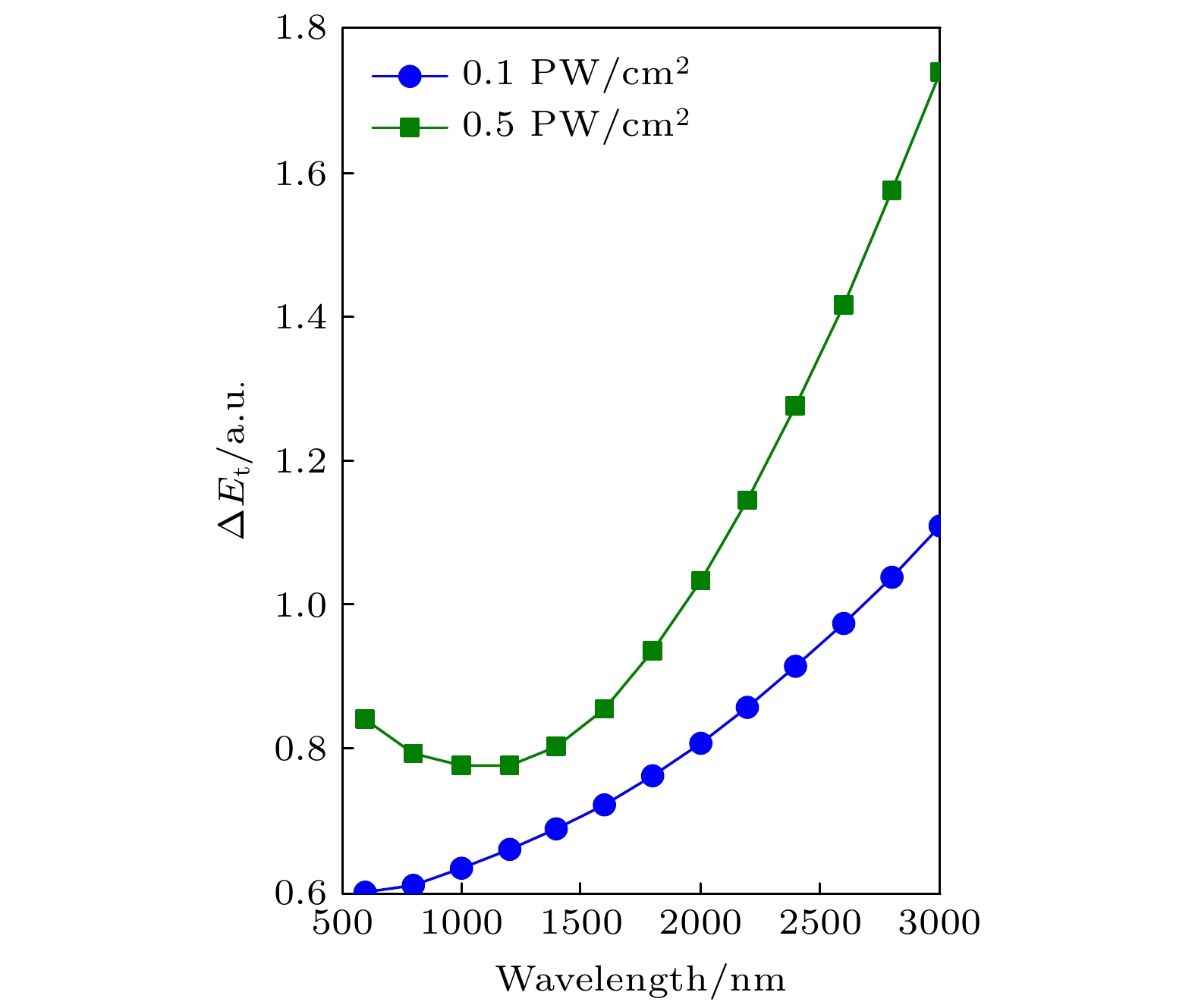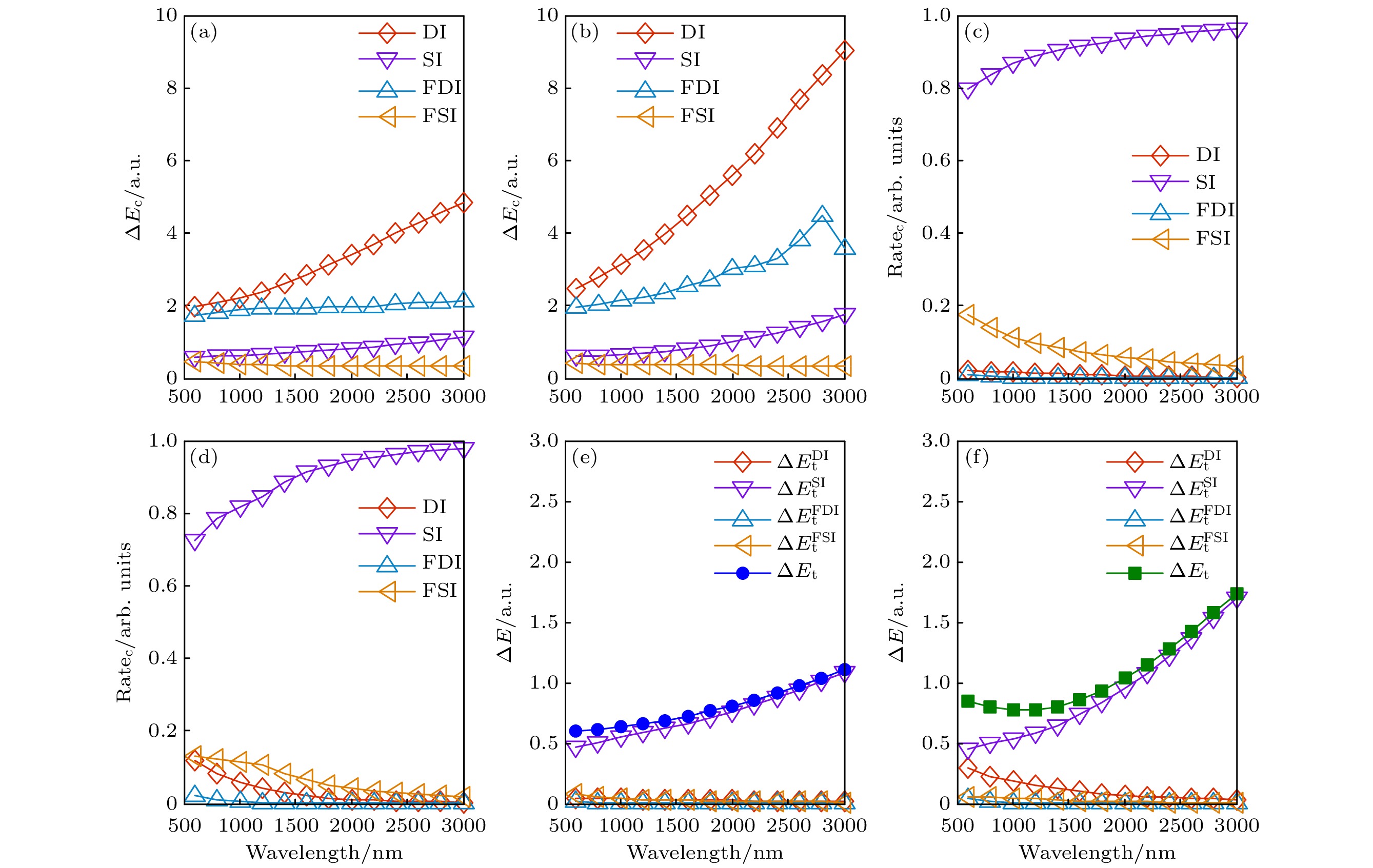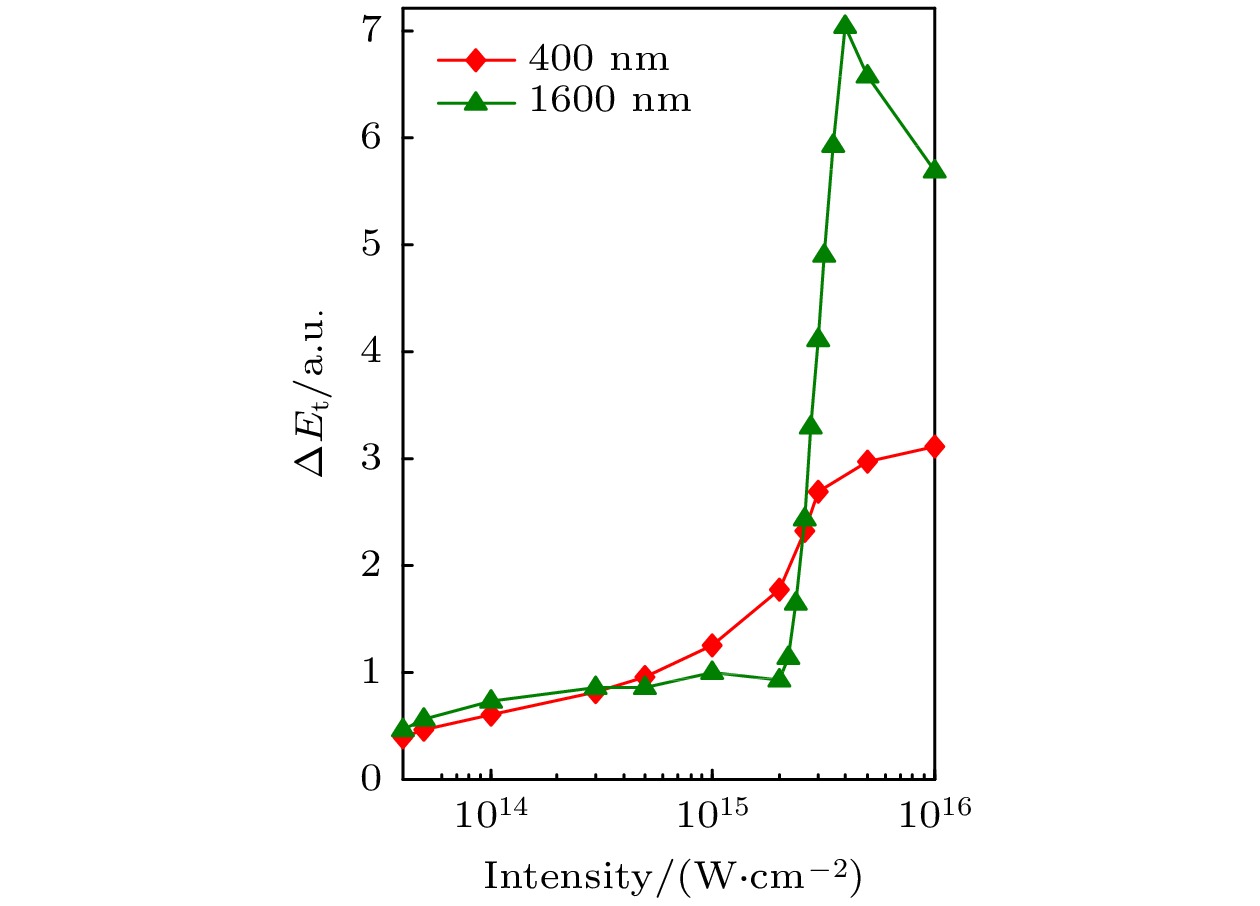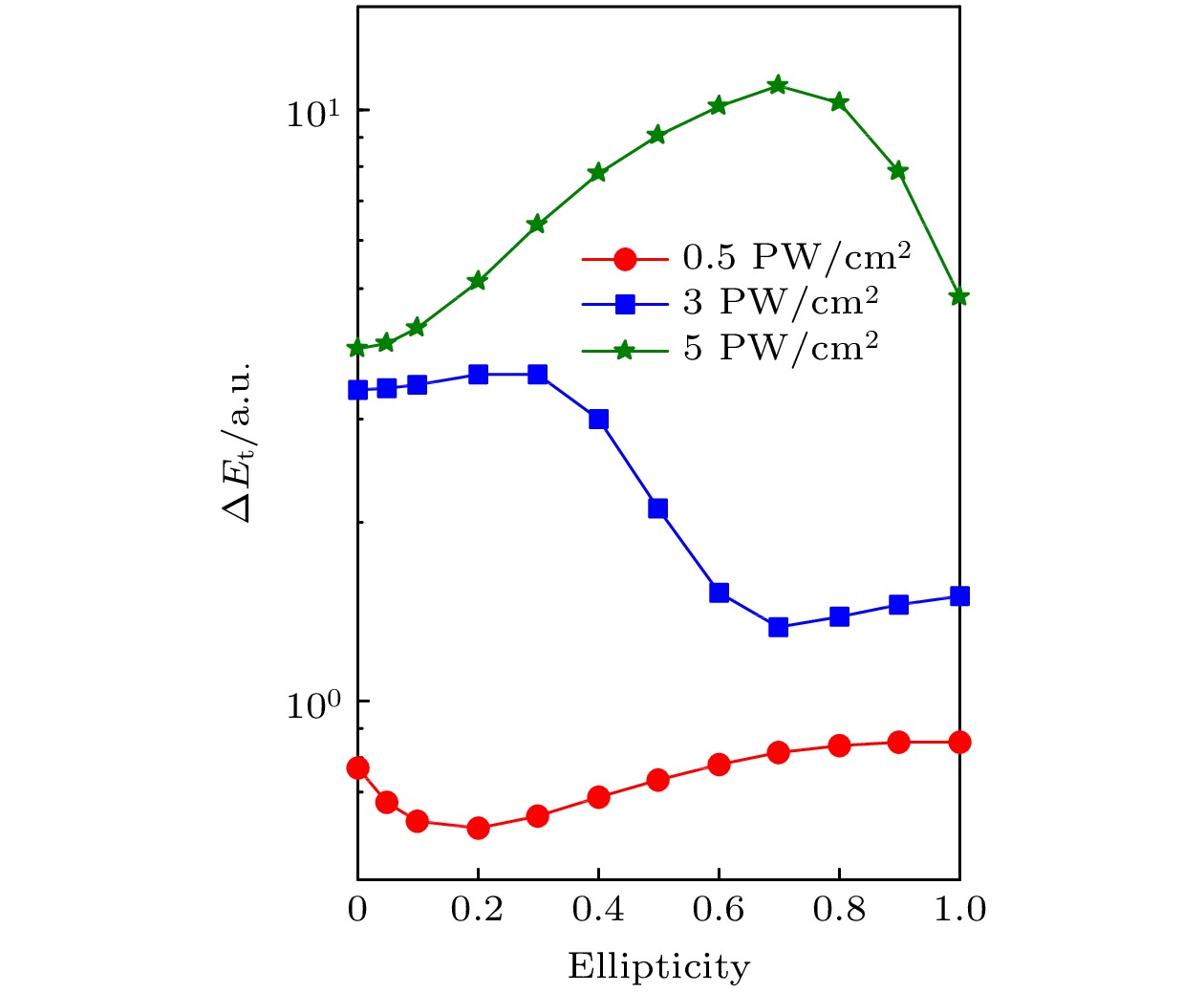-
Using the three-dimensional classical ensemble model, we investigate the dependence of the energy absorbed by two electrons (Ar atom as an example) from the laser field on the laser parameters (wavelength, laser intensity and ellipticity). The results show that when the laser intensity is fixed and the wavelength increases, the energy absorbed by the two electrons from the laser field increases as a whole, but the trend is slightly different under different intensities. At lower intensity the dependence of the energy absorbed by the two electrons from the laser field on wavelength increases steadily and at higher intensity it decreases slowly and then increases rapidly. The intensity dependence of the energy absorbed by two electrons from the laser field in the whole ensemble presents two interesting intersections at different wavelengths. The dependence of the energy absorbed by the two electrons from the laser field on the ellipticity first decreases and then increases slowly at lower intensity; it has a “Ladder shape” that slowly increases and then decreases and finally slowly increases at moderate intensity; it shows a trend of increasing first and then decreasing at higher intensities. In order to explain the dependence of the energy absorbed by two electrons from the laser field on the laser parameters (wavelength, laser intensity and ellipticity), the kinetic process of the whole ensemble is divided into four channels: double ionization, single ionization, frustrated single ionization and frustrated double ionization. The characteristics of each channel and how it dominates the overall trend of energy absorption from the laser field by the two electrons are then analyzed. The analysis results show that the dependence of the energy absorbed by the two electrons from the laser field on wavelength、laser intensity and ellipticity is due to the fact that some channels dominate the energy absorbed by the two electrons from the laser field.
-
Keywords:
- ultrafast dynamics of atom /
- single ionization /
- double ionization /
- frustrated single ionization /
- frustrated double ionization
[1] Paulus G G, Nicklich W, Xu H, Lambropoulos P, Walther H 1994 Phys. Rev. Lett. 72 2851
 Google Scholar
Google Scholar
[2] Becker W, Grasbon F, Kopold R, Miloševic D B, Paulus G G, Walther H 2002 Adv. At. Mol. Opt. Phys. 48 35
[3] McPherson A, Gibson G, Jara H, Johann U, Luk T S, McIntyre I A, Boyer K, Rhodes C K 1987 J. Opt. Soc. Am. B 4 595
 Google Scholar
Google Scholar
[4] Seres J, Seres E, Verhoef A J, Tempea G, Streli C, Wobrauschek P, Yakovlev V, Scrinzi A, Spielmann C, Krausz F 2005 Nature 433 596
 Google Scholar
Google Scholar
[5] Krausz F, Ivanov M 2009 Rev. Mod. Phys. 81 163
 Google Scholar
Google Scholar
[6] Zhai C Y, Zhu X S, Long J, Shao R Z, Zhang Y F, He L X, Tang Q B, Li Y B, Lan P F, Yu B H, Lu P X 2021 Phys. Rev. A 103 033104
 Google Scholar
Google Scholar
[7] Sun F H, Chen X, Zhang W B, Qiang J J, Li H, Lu P F, Gong X C, Ji Q Y, Lin K, Li H X, Tong J H, Chen F, Ruiz C, Wu J, He F 2020 Phys. Rev. A 101 021402
 Google Scholar
Google Scholar
[8] Kang H P, Chen S, Wang Y L, Chu W, Yao J P, Chen J, Liu X J, Cheng Y, Xu Z Z 2019 Phys. Rev. A 100 033403
 Google Scholar
Google Scholar
[9] Liu Y, Fu L B, Ye D F, Liu J, Li M, Wu C Y, Gong Q H, Moshammer R, Ullrich J 2014 Phys. Rev. Lett. 112 013003
 Google Scholar
Google Scholar
[10] Zhou Y M, Liao Q, Lu P X 2009 Phys. Rev. A 80 023412
 Google Scholar
Google Scholar
[11] Li H Y, Chen J, Jiang H B, Liu J, Fu P M, Gong Q H, Yan Z C, Wang B B 2009 J. Phys. B 42 125601
 Google Scholar
Google Scholar
[12] Quan W, Hao X L, Hu X Q, Sun R P, Wang Y L, Chen Y J, Yu S G, Xu S P, Xiao Z L, Lai X Y, Li X Y, Becker W, Wu Y, Wang J G, Liu X J, Chen J 2017 Phys. Rev. Lett. 119 243203
 Google Scholar
Google Scholar
[13] Chen Z J, Wen H, Liu F, Morishita T, Zatsarinny O, Bartschat K 2020 Opt. Express 28 6490
 Google Scholar
Google Scholar
[14] 余本海, 李盈傧, 汤清彬 2012 物理学报 61 203201
 Google Scholar
Google Scholar
Yu B H, Li Y B, Tang Q B 2012 Acta Phys. Sin. 61 203201
 Google Scholar
Google Scholar
[15] Li Y B, Wang X, Yu B H, Tang Q B, Wang G H, Wan J G 2016 Sci. Rep. 6 37413
 Google Scholar
Google Scholar
[16] Li Y B, Yu B H, Tang Q B, Wang X, Hua D Y, Tong A H, Jiang C H, Ge G X, Li Y C, Wan J G 2016 Opt. Express 24 6469
 Google Scholar
Google Scholar
[17] Liao Q, Winney A H, Lee S K, Lin Y F, Adhikari P, Li W 2017 Phys. Rev. A 96 023401
 Google Scholar
Google Scholar
[18] Liao Q, Li Y, Qin M Y, Lu P X 2017 Phys. Rev. A 96 063408
 Google Scholar
Google Scholar
[19] Schafer K J, Young B, DiMauro L F, Kulander K C 1993 Phys. Rev. Lett. 70 1599
 Google Scholar
Google Scholar
[20] Corkum P B 1993 Phys. Rev. Lett. 71 1994
 Google Scholar
Google Scholar
[21] Zhou Y M, Huang C, Lu P X 2012 Opt. Express 20 20201
 Google Scholar
Google Scholar
[22] Pfeiffer A N, Cirelli C, Smolarski M, Dörner R, Keller U 2011 Nature 7 428
[23] Zhou Y M, Huang C, Liao Q, Lu P X 2012 Phys. Rev. Lett. 109 053004
 Google Scholar
Google Scholar
[24] Wang X, Eberly J H 2009 Phys. Rev. Lett. 103 103007
 Google Scholar
Google Scholar
[25] Shvetsov-Shilovski N I, Sayler A M, Rathje T, Paulus G G 2011 Phys. Rev. A 83 033401
 Google Scholar
Google Scholar
[26] Fleischer A, Wörner H J, Arissian L, Liu L R, Meckel M, Rippert A, Dörner R, Villeneuve D M, Corkum P B, Staudte A 2011 Phys. Rev. Lett. 107 113003
 Google Scholar
Google Scholar
[27] Wang X, Tian Justin, Eberly J H 2013 Phys. Rev. Lett. 110 073001
 Google Scholar
Google Scholar
[28] Nubbemeyer T, Gorling K, Saenz A, Eichmann U, Sandner W 2008 Phys. Rev. Lett. 101 233001
 Google Scholar
Google Scholar
[29] Manschwetus B, Nubbemeyer T, Gorling K, Steinmeyer G, Eichmann U, Rottke H, Sandner W 2009 Phys. Rev. Lett. 102 113002
 Google Scholar
Google Scholar
[30] Ulrich B, Vredenborg A, Malakzadeh A, Meckel M, Cole K, Smolarski M, Chang Z, Jahnke T, Dörner R 2010 Phys. Rev. A 82 013412
 Google Scholar
Google Scholar
[31] Shomsky K N, Smith Z S, Hann S L 2009 Phys. Rev. A 79 061402
 Google Scholar
Google Scholar
[32] Sayler A M, McKenna J, Gaire B, Kling N G, Carnes K D, Ben-Itzhak I 2012 Phys. Rev. A 86 033425
 Google Scholar
Google Scholar
[33] Chen A, Price H, Staudte A, Emmanouilidou A 2016 Phys. Rev. A 94 043408
 Google Scholar
Google Scholar
[34] Larimian S, Erattupuzha S, Baltuška A, Kitzler-Zeiler M, Xie X 2020 Phys. Rev. Res. 2 013021
 Google Scholar
Google Scholar
[35] Li Y B, Xu J K, Yu B H, Wang X 2020 Opt. Express 28 7341
 Google Scholar
Google Scholar
[36] Parker J S, Doherty B J S, Taylor K T, Schultz K D, Blaga C I, DiMauro L F 2006 Phys. Rev. Lett. 96 133001
 Google Scholar
Google Scholar
[37] Liu A H, Thumm Uwe 2014 Phys. Rev. A 89 063423
 Google Scholar
Google Scholar
[38] Liu A H, Thumm Uwe 2015 Phys. Rev. A 91 043416
 Google Scholar
Google Scholar
[39] Chen J, Nam C H 2002 Phys. Rev. A 66 053415
 Google Scholar
Google Scholar
[40] Panli R, Eberly J H, Haan S L 2001 Opt. Express 8 431
 Google Scholar
Google Scholar
[41] Haan S L, Breen L, Karim A, Eberly J H 2006 Phys. Rev. Lett. 97 103008
 Google Scholar
Google Scholar
[42] Haan S L, Van Dyke J S, Smith Z S 2008 Phys. Rev. Lett. 101 113001
 Google Scholar
Google Scholar
[43] Wang X, Eberly J H 2010 Phys. Rev. Lett. 105 083001
 Google Scholar
Google Scholar
[44] Li Y B, Mei L L, Chen H M, Xu J K, Tang Q B, Zhao Y G, Han Q Q, Wang C L, Tong A H, Ge G X, Yu B H 2018 Int. J. Mod. Phys. B 32 1850302
 Google Scholar
Google Scholar
[45] Li Y B, Xu J K, Chen H M, Li Y H, He J J, Qin L L, Shi L K, Zhao Y G, Tang Q B, Zhai C Y, Yu B H 2021 Opt. Commun. 493 127019
 Google Scholar
Google Scholar
-
图 1 整个系综两电子从激光场吸收的能量
$ \Delta {E_{\text{t}}} $ 随波长的变化曲线, 对应的激光强度分别为0.1 PW/cm2 (深蓝色实心圆点) 和 0.5 PW/cm2 (绿色实心方块).Figure 1. Energy absorbed by two electrons from the laser field in the whole ensemble
$ \Delta {E_{\text{t}}} $ as a function of wavelength, the corresponding laser intensities are 0.1 PW/cm2 (dark blue solid dot) and 0.5 PW/cm2 (green solid square) respectively.图 2 双电子系统与激光相互作用时4种典型的物理过程: DI, SI, FDI和FSI. 左列: 两个电子的能量随时间的演化, 右列: 两个电子到原子核的距离随时间的演化.
Figure 2. There are four typical physical processes in the interaction between a two-electron system and a laser: DI, SI, FDI and FSI. Left column: the energy of the two electrons as a function of time; right column: the distance between the two electrons and the nucleus as a function of time.
图 3 4种通道的波长依赖 (a) (b) 4种通道下两电子从激光场吸收的能量
$ \Delta {E_{\text{c}}} $ 随波长的变化曲线; (c) (d) 4种通道的产率随波长的变化曲线; (e) (f) 4种通道在整个系综中两电子从激光场吸收的能量$ \Delta E_{\text{t}}^{\text{c}} $ 随波长的变化曲线以及整个系综两电子从激光场吸收的能量$ \Delta {E_{\text{t}}} $ 随波长的变化曲线. 左列和右列对应的激光强度分别为0.1和0.5 PW/cm2.Figure 3. Wavelength dependence of the four channels: (a) (b)
$ \Delta {E_{\text{c}}} $ as a function of wavelength in four channels; (c) (d) probabilities of the four channels as a function of wavelength; (e) (f)$ \Delta E_{\text{t}}^{\text{c}} $ and$ \Delta {E_{\text{t}}} $ as a function of wavelength. The laser intensities corresponding to the left and right columns are 0.1 and 0.5 PW/cm2.图 4 整个系综两电子从激光场吸收的能量
$ \Delta {E_{\text{t}}} $ 随强度的变化曲线, 对应的波长分别为400 nm (红色实心菱形线) 和1600 nm (绿色实心三角形线).Figure 4. Energy absorbed by two electrons from the laser field in the whole ensemble
$ \Delta {E_{\text{t}}} $ as a function of intensity, the corresponding wavelengths are 400 nm (red solid diamond line) and 1600 nm (green solid triangle line) respectively.图 5 (a)−(d)不同波长下4种通道两电子从激光场吸收的能量
$ \Delta {E_{\text{c}}} $ 随强度的变化曲线; (e)−(h)不同波长下4种通道的产率随强度的变化曲线; (i)−(l)不同波长下4种通道在整个系综中两电子从激光场吸收的能量$ \Delta E_{\text{t}}^{\text{c}} $ 随强度的变化曲线. 从左到右依次为DI, SI, FDI和FSI通道. 红色空心菱形(三角形)代表DI通道, 紫色空心菱形(三角形)代表SI通道, 浅蓝色空心菱形(三角形)代表FDI通道, 橙色空心菱形(三角形)代表FSI通道. 对应的波长分别为400 nm (菱形)和1600 nm (三角形).Figure 5. (a)−(d)
$ \Delta {E_{\text{c}}} $ in four channels at different wavelengths as a function of intensity; (e)−(h) probabilities of the four channels as a function of intensity at different wavelengths; (i)−(l)$ \Delta E_{\text{t}}^{\text{c}} $ in four channels as a function of intensity at different wavelengths. From left to right are DI, SI, FDI and FSI channels. The red hollow diamond (triangle) represents DI channel, the purple hollow diamond (triangle) represents SI channel, the light blue hollow diamond (triangle) represents FDI channel, and the orange hollow diamond (triangle) represents FSI channel. The corresponding wavelengths are 400 nm (diamond) and 1600 nm (triangle), respectively.图 6 整个系综两电子从激光场吸收的能量
$ \Delta {E_{\text{t}}} $ 随椭偏率的变化, 对应的激光强度分别为0.5 PW/cm2 (红色实心圆形线)、3 PW/cm2 (深蓝色实心方形线) 和5 PW/cm2 (绿色实心五角星形线), 波长为800 nm.Figure 6. Energy absorbed by two electrons from the laser field in the whole ensemble
$ \Delta {E_{\text{t}}} $ as a function of ellipticity, The corresponding laser intensities are 0.5 PW/cm2 (red solid circular line), 3 PW/cm2 (dark blue solid square line) and 5 PW/cm2 (green solid pentagram line), the wavelength is 800 nm.图 7 4种通道的椭偏率依赖 (a)−(c) 4种通道下两电子从激光场吸收的能量
$ \Delta {E_{\text{c}}} $ 随椭偏率的变化; (d)−(f) 4种通道的产率随椭偏率的变化; (g)−(i) 4种通道在整个系综中两电子从激光场吸收的能量$ \Delta E_{\text{t}}^{\text{c}} $ 随椭偏率的变化以及整个系综两电子从激光场吸收的能量$ \Delta {E_{\text{t}}} $ 随椭偏率的变化. 左列、中间列、右列对应的激光强度分别为0.5, 3 和5 PW/cm2.Figure 7. Ellipticity dependence of the four channels: (a)−(c)
$ \Delta {E_{\text{c}}} $ as a function of ellipticity in four channels; (d)−(f) probabilities of the four channels as a function of ellipticity; (g)−(i)$ \Delta E_{\text{t}}^{\text{c}} $ and$ \Delta {E_{\text{t}}} $ as a function of ellipticity. The laser intensities of the left, middle and right columns are 0.5, 3 and 5 PW/cm2. -
[1] Paulus G G, Nicklich W, Xu H, Lambropoulos P, Walther H 1994 Phys. Rev. Lett. 72 2851
 Google Scholar
Google Scholar
[2] Becker W, Grasbon F, Kopold R, Miloševic D B, Paulus G G, Walther H 2002 Adv. At. Mol. Opt. Phys. 48 35
[3] McPherson A, Gibson G, Jara H, Johann U, Luk T S, McIntyre I A, Boyer K, Rhodes C K 1987 J. Opt. Soc. Am. B 4 595
 Google Scholar
Google Scholar
[4] Seres J, Seres E, Verhoef A J, Tempea G, Streli C, Wobrauschek P, Yakovlev V, Scrinzi A, Spielmann C, Krausz F 2005 Nature 433 596
 Google Scholar
Google Scholar
[5] Krausz F, Ivanov M 2009 Rev. Mod. Phys. 81 163
 Google Scholar
Google Scholar
[6] Zhai C Y, Zhu X S, Long J, Shao R Z, Zhang Y F, He L X, Tang Q B, Li Y B, Lan P F, Yu B H, Lu P X 2021 Phys. Rev. A 103 033104
 Google Scholar
Google Scholar
[7] Sun F H, Chen X, Zhang W B, Qiang J J, Li H, Lu P F, Gong X C, Ji Q Y, Lin K, Li H X, Tong J H, Chen F, Ruiz C, Wu J, He F 2020 Phys. Rev. A 101 021402
 Google Scholar
Google Scholar
[8] Kang H P, Chen S, Wang Y L, Chu W, Yao J P, Chen J, Liu X J, Cheng Y, Xu Z Z 2019 Phys. Rev. A 100 033403
 Google Scholar
Google Scholar
[9] Liu Y, Fu L B, Ye D F, Liu J, Li M, Wu C Y, Gong Q H, Moshammer R, Ullrich J 2014 Phys. Rev. Lett. 112 013003
 Google Scholar
Google Scholar
[10] Zhou Y M, Liao Q, Lu P X 2009 Phys. Rev. A 80 023412
 Google Scholar
Google Scholar
[11] Li H Y, Chen J, Jiang H B, Liu J, Fu P M, Gong Q H, Yan Z C, Wang B B 2009 J. Phys. B 42 125601
 Google Scholar
Google Scholar
[12] Quan W, Hao X L, Hu X Q, Sun R P, Wang Y L, Chen Y J, Yu S G, Xu S P, Xiao Z L, Lai X Y, Li X Y, Becker W, Wu Y, Wang J G, Liu X J, Chen J 2017 Phys. Rev. Lett. 119 243203
 Google Scholar
Google Scholar
[13] Chen Z J, Wen H, Liu F, Morishita T, Zatsarinny O, Bartschat K 2020 Opt. Express 28 6490
 Google Scholar
Google Scholar
[14] 余本海, 李盈傧, 汤清彬 2012 物理学报 61 203201
 Google Scholar
Google Scholar
Yu B H, Li Y B, Tang Q B 2012 Acta Phys. Sin. 61 203201
 Google Scholar
Google Scholar
[15] Li Y B, Wang X, Yu B H, Tang Q B, Wang G H, Wan J G 2016 Sci. Rep. 6 37413
 Google Scholar
Google Scholar
[16] Li Y B, Yu B H, Tang Q B, Wang X, Hua D Y, Tong A H, Jiang C H, Ge G X, Li Y C, Wan J G 2016 Opt. Express 24 6469
 Google Scholar
Google Scholar
[17] Liao Q, Winney A H, Lee S K, Lin Y F, Adhikari P, Li W 2017 Phys. Rev. A 96 023401
 Google Scholar
Google Scholar
[18] Liao Q, Li Y, Qin M Y, Lu P X 2017 Phys. Rev. A 96 063408
 Google Scholar
Google Scholar
[19] Schafer K J, Young B, DiMauro L F, Kulander K C 1993 Phys. Rev. Lett. 70 1599
 Google Scholar
Google Scholar
[20] Corkum P B 1993 Phys. Rev. Lett. 71 1994
 Google Scholar
Google Scholar
[21] Zhou Y M, Huang C, Lu P X 2012 Opt. Express 20 20201
 Google Scholar
Google Scholar
[22] Pfeiffer A N, Cirelli C, Smolarski M, Dörner R, Keller U 2011 Nature 7 428
[23] Zhou Y M, Huang C, Liao Q, Lu P X 2012 Phys. Rev. Lett. 109 053004
 Google Scholar
Google Scholar
[24] Wang X, Eberly J H 2009 Phys. Rev. Lett. 103 103007
 Google Scholar
Google Scholar
[25] Shvetsov-Shilovski N I, Sayler A M, Rathje T, Paulus G G 2011 Phys. Rev. A 83 033401
 Google Scholar
Google Scholar
[26] Fleischer A, Wörner H J, Arissian L, Liu L R, Meckel M, Rippert A, Dörner R, Villeneuve D M, Corkum P B, Staudte A 2011 Phys. Rev. Lett. 107 113003
 Google Scholar
Google Scholar
[27] Wang X, Tian Justin, Eberly J H 2013 Phys. Rev. Lett. 110 073001
 Google Scholar
Google Scholar
[28] Nubbemeyer T, Gorling K, Saenz A, Eichmann U, Sandner W 2008 Phys. Rev. Lett. 101 233001
 Google Scholar
Google Scholar
[29] Manschwetus B, Nubbemeyer T, Gorling K, Steinmeyer G, Eichmann U, Rottke H, Sandner W 2009 Phys. Rev. Lett. 102 113002
 Google Scholar
Google Scholar
[30] Ulrich B, Vredenborg A, Malakzadeh A, Meckel M, Cole K, Smolarski M, Chang Z, Jahnke T, Dörner R 2010 Phys. Rev. A 82 013412
 Google Scholar
Google Scholar
[31] Shomsky K N, Smith Z S, Hann S L 2009 Phys. Rev. A 79 061402
 Google Scholar
Google Scholar
[32] Sayler A M, McKenna J, Gaire B, Kling N G, Carnes K D, Ben-Itzhak I 2012 Phys. Rev. A 86 033425
 Google Scholar
Google Scholar
[33] Chen A, Price H, Staudte A, Emmanouilidou A 2016 Phys. Rev. A 94 043408
 Google Scholar
Google Scholar
[34] Larimian S, Erattupuzha S, Baltuška A, Kitzler-Zeiler M, Xie X 2020 Phys. Rev. Res. 2 013021
 Google Scholar
Google Scholar
[35] Li Y B, Xu J K, Yu B H, Wang X 2020 Opt. Express 28 7341
 Google Scholar
Google Scholar
[36] Parker J S, Doherty B J S, Taylor K T, Schultz K D, Blaga C I, DiMauro L F 2006 Phys. Rev. Lett. 96 133001
 Google Scholar
Google Scholar
[37] Liu A H, Thumm Uwe 2014 Phys. Rev. A 89 063423
 Google Scholar
Google Scholar
[38] Liu A H, Thumm Uwe 2015 Phys. Rev. A 91 043416
 Google Scholar
Google Scholar
[39] Chen J, Nam C H 2002 Phys. Rev. A 66 053415
 Google Scholar
Google Scholar
[40] Panli R, Eberly J H, Haan S L 2001 Opt. Express 8 431
 Google Scholar
Google Scholar
[41] Haan S L, Breen L, Karim A, Eberly J H 2006 Phys. Rev. Lett. 97 103008
 Google Scholar
Google Scholar
[42] Haan S L, Van Dyke J S, Smith Z S 2008 Phys. Rev. Lett. 101 113001
 Google Scholar
Google Scholar
[43] Wang X, Eberly J H 2010 Phys. Rev. Lett. 105 083001
 Google Scholar
Google Scholar
[44] Li Y B, Mei L L, Chen H M, Xu J K, Tang Q B, Zhao Y G, Han Q Q, Wang C L, Tong A H, Ge G X, Yu B H 2018 Int. J. Mod. Phys. B 32 1850302
 Google Scholar
Google Scholar
[45] Li Y B, Xu J K, Chen H M, Li Y H, He J J, Qin L L, Shi L K, Zhao Y G, Tang Q B, Zhai C Y, Yu B H 2021 Opt. Commun. 493 127019
 Google Scholar
Google Scholar
Catalog
Metrics
- Abstract views: 7861
- PDF Downloads: 216
- Cited By: 0

















 DownLoad:
DownLoad:


























